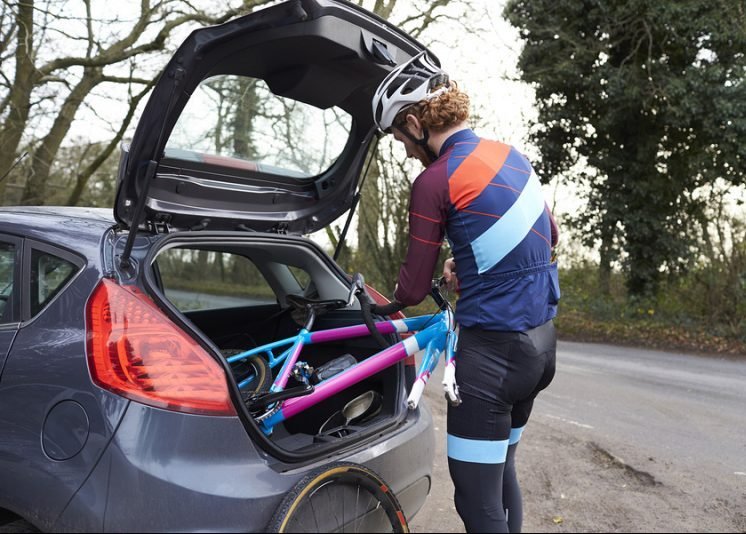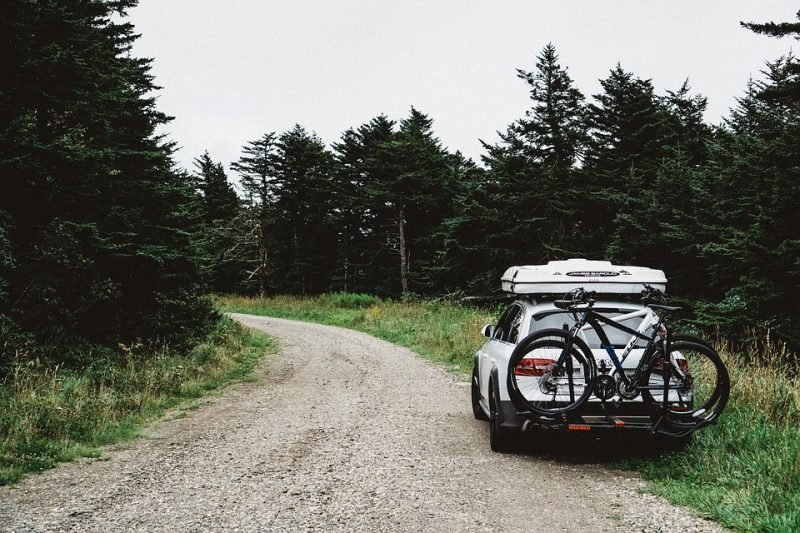How to Put a Bike on a Bike Rack: Your Basic Guidelines

Adventure-minded people or those who would want to transport their bikes from one place to another may have encountered challenges on how to do this. While loading a bike on a car comes with challenges, the question of how to put a bike on a bike rack is common.
Cars are not designed to carry bikes. A fully-assembled bike doesn’t fit in there, which is why add-ons are necessary to attach it anywhere outside the car. This is where the use of bike rack comes into play.
But before learning the tips and tricks in placing your bike on its rack, let’s first consider the carrying options for your bike racks for cars.
Bike-carrying options
1) In the boot
Get your bike in the boot if your saloon car is equipped with large space. You will be amazed by the minimal disassembly this option promises. You need to drop out the bike’s front wheel and its saddle.
This option offers safety to your bike, easy loading, convenience, and without additional cost. However, it may not provide enough room for anything else in your car.
For more safety precautions, equip your car with advanced alarm system to ward off potential theft threats. You do not wish risking your expensive bikes get stolen.

2) In estate car
Estate car’s huge load space is best for bikes, especially when their rear seats are folded.
Bikes are provided with reasonable security against theft. There is a negligible impact on your fuel consumption. You will be spared from any additional cost. Safety of the bike from elements is also promised.
However, considering this option can make the interior of your car dirty. It necessitates you to always drive around in a box.

3) Roof rack
This traditional bike carrying method uses space above the car’s head. Some designs may require you to take off the front wheel. There are also those with an extra arm to grab the bike’s frame.
This option is feasible to carry as much as four bikes with the spacious roof of your car. The roof bars can still carry other stuff. Your bike spares your car from any damage.
You need to look out for low entrances just like in car garages and parks. It is worst for the fuel consumption of your car. The bike can get dirty or wet in bad weather.
Loading your bike this way can be awkward. There’s a challenge in quickly fitting or removing your bike.

4) Hatch or Boot Rack
This is probably the most popular method to carry your bike. The rack is held on the car by straps. Its padding is where the rack rests on your car alongside two arms for your bike. There are also those with much-sophisticated designs with cradles for your bike.
Loading in this method is easy. It would be quick to remove or fit your bike. It’s cost-effective and folds for proper storage. It has a lesser impact on your fuel consumption.
It restricts access to the car’s back area. The security is at risk as it can obscure lights and the plate. This can cause damage to the paintwork of your car. An extra lock is necessary to prevent any theft.
With knowledge on the possible ways to attach your bike to your car, you are now ready to do the job – attach the bike on your car.

Proper set-up of the bike on a bike rack
A bike rack is very useful as it attaches your bike to the car and locks the bike while traveling across the town or city. There are circumstances when navigating bike racks can be tricky. So, how to put a bike on a bike rack then? Follow these steps:
Step to follow for simple set-up on how to a bike on a bike rack
1. Opening up the bike rack
Follow the instructions in the manual as different rack brands have various fixing methods. The rack’s open shape varies based on the model and design though most racks show a big arc when they are completely opened.
Make the tusks sit in its upright position. Do not let the rack lie flat on a hatchback glass. Position the rack a bit closer to the car bumper with heavy cambered hatchbacks. Do this further down to prevent damage or anchor the payload.
Make a mark for the correct rack element angle logging on racks equipped with ratcheting adjustments.
2. Carefully Strapping the Rack to the Car
Each of the somewhat confusing tangles of the rack’s straps has an important purpose. Everything is expected to fall into a certain place when systematically approached.
Usually, the top adjustments are locking affairs and double looping to prevent any risk to loose whenever loaded. Installation time will be lesser once you have identified and fine-tuned the correct length.
See to it that you have properly attached and securely tightened the lateral straps. Try to drive slowly around tight bends and at roundabouts if the rack does not have lateral straps. You can use any extra strap lengths to keep the bike tidy and secure at speed.
Use hardened steel U-locks to fasten the bike on your car. These are incredible locks since they are difficult to break open without using serious tools.
Never use combination locks or cable locks because they are easy to pick and cut through. You may use these locks for accessories in securing the saddle or wheels to the frame.
3. Padding the Delicate Parts Whenever Needed
Use enough padding to keep your bike from sensitive bits to avoid any contact with the metal parts. This even offers safety in carrying the carbon bikes. You have to diffuse the pressure over a huge area.
Remove the front wheel of the bike so that the package will be more compact. Keep the bike from protruding past the side of the driver into traffic. Install a foam cladding stretch between the rack tusk and top-tube.
Place one tusk through the rear wheel or triangle to mitigate frame damage. Remember not to obstruct the exhaust pipe. Spare light board when the number plate and lights are obstructed.
4. Lashing the Bike to the Rack with Excess Straps
Double safeguard your bike by lashing it to the rack. This helps prevent unfavorable things like flying off bikes on the motorway. Just attach the top tube to the bike rack using the straps.
You also use your old toe straps but make sure their buckles do not scratch your paint. Next step is to anchor the bike’s lower portions to the rack to lessen any pendulum-type bouncing or swinging.
Turn its bar sideways then strap it to the top tube to keep the movement. Use a saddle cover or taped up bag in protecting the leather saddles. Immobilize the front and/or rear wheels to stop them from spinning. This can cause distraction or annoyance in your rear view mirror.
5. Tensioning up the Rack’s Lower Straps
The foam cladding protectors of your bike will be compressed once it is loaded up. This loses the tension to its lower straps, which may unclip the straps on the road. You should reach down the lower buckles and cinch them up. Just pull on its free strap bit.
Shake the bike to test that nothing bangs against anything else, which may lead to potential damage. Note that anything hard or rough in contact with the bike can cause surface damage over longer trips.
Always re-check on this then tie protective rag strips or add any pipe cladding if needed to. Go on with your drive but always remember to obey the speed limits and drive safely to keep your bike at ease.

Riding is fun, bringing it to the point come with some tips and tricks.
Tips and Tricks
Aside from the information above, there are other things or factors you need to consider:
- Always purchase high-quality locks for the safety and security of your bike.
- Whenever possible, register your bike with the local police department.
- Alternate each bike’s direction, if you are loading multiple bikes onto the rack at once. This will ensure that their handlebars will not conflict with each other.
- Take out the valuable accessories (such as bags or lights) before locking up your bike.
- Never leave your car with the bike on its rack out of your sight.
- It is not worthy to load the bike the night before. The luxurious and pricey bikes stack inside a car are appealing to the thieves.
Security is a big issue with carrying a variety of bikes on a journey or adventure. The answer for you is to know how to put a bike on a bike rack. It has to be locked to the rack as you stop.
A bike rack can be expensive, but it’s a feat of design and engineering. This offers several years of reliable and dependable service. It’s relatively easy for an individual to deal with.
